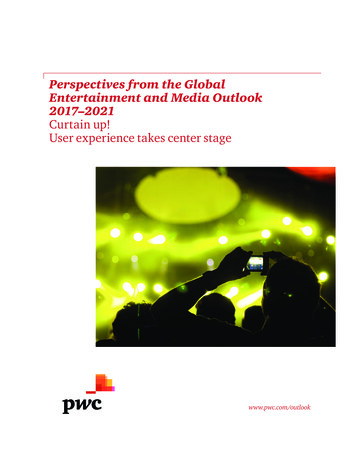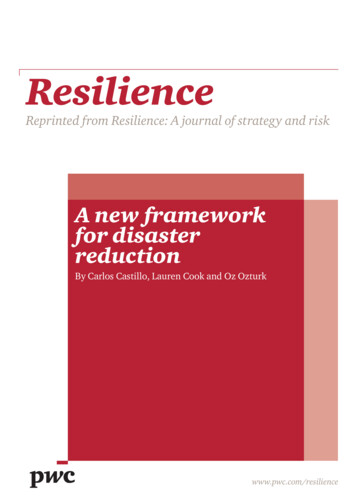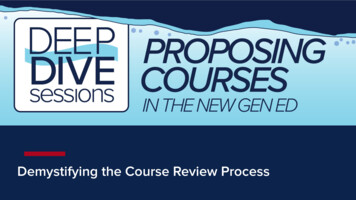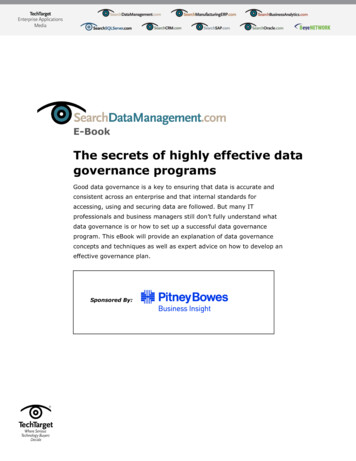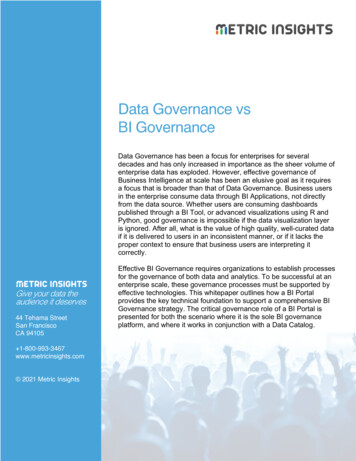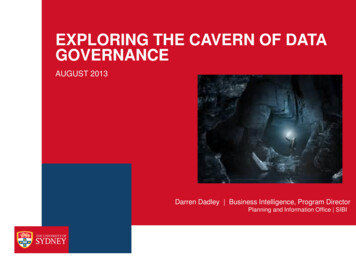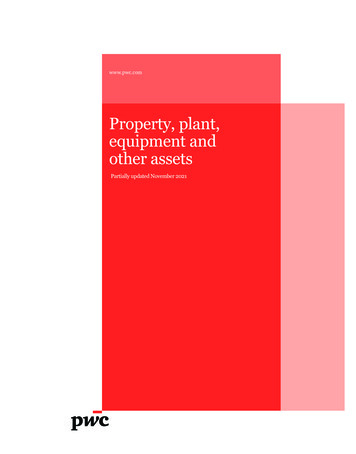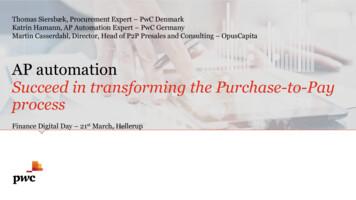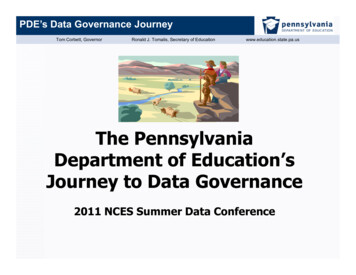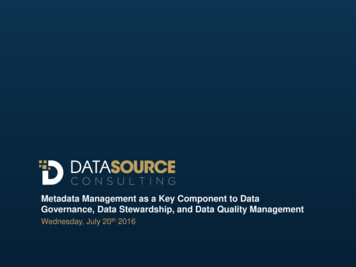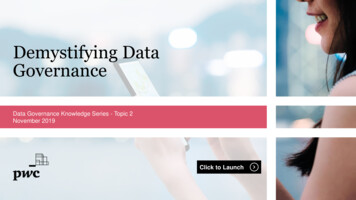
Transcription
Demystifying DataGovernanceData Governance Knowledge Series - Topic 2November 2019Click to LaunchPwCDemystifying data governance
Busting some common mythsThe objective of data governance is for an organisation tohave greater control over its data assets. Data governance isachieved by planning, monitoring and enforcing stringentpolicies, standards and procedures. However, exercisingauthority over large volumes of data can be a complicatedprocess for an organisation and it may require other businessdepartments, such as human resources, processes andtechnology to get involved, thereby causing misconceptionsover data governance.A few common misconceptions on data governance arediscussed below.Data governance is a technology-focused activityFor a successful data governance programme in anorganisation, both business and IT departments should cometogether and share equal responsibility. A successful datagovernance model can only be implemented when it is ownedby the business and enabled by the IT departmentsrespectively, to reap benefits and create business value fromprocesses and data assets. The Responsible, Accountable,Consulted and/or Informed (RACI) chart is an effectiveintegrating mechanism which defines clear roles on datagovernance within an organisation to overcome anymisunderstanding.Data governance is a one-time activityData governance requires the latest technologyThe perception that data governance is a one-time activityarises because organisations tend to believe that exercisingauthority and control and defining data policies and processesfor once will result in the organisation continuing to achieve thedesired business objectives. Organisations tend to ignore thefact that organisational risks change with external parametersand need continuous monitoring, changes in data governancepolicies, standards, architecture, procedures and metrics.It is often perceived that latest technologies are required foran effective data governance model to be operational. It istrue that tools and technologies facilitate data governanceprogrammes. However, to have a greater control over existingdata assets, governance tools can also be integrated withexisting technologies. Also, if the mitigation of data securityissues is achieved in a cost-effective manner by using newtechnology that fits with the current technology in use, the newtechnology can be adopted.Overlooking the key outcomeOften, organisations miss out on the holistic purpose of datagovernance and perceive that regulatory compliance,improving data quality, having in place adequate data securitymeasures, obtaining data lineage or documenting metadataare the only activities under the data governance programme.Underestimating the overall scope of data governance doesnot benefit the organisation.StewardshipArchitectureBusiness GlossaryData Management Data QualityArchitecture Metadata CatalogAccess Data Lineage RegulationsTools ControlStandardsPoliciesData GovernanceData QualityMonetization RegulationsControl ProceduresBusiness Glossary Privacy Laws Data ManagementFigure 1: Word cloud on data governancePwCDemystifying data governance2
PwC’s Data Governance Framework and its scopeThe above myths can be clarified by an industry accepted DataGovernance framework that applies the data governance core principlesacross core data governance areas and their interaction with datamanagement components and data lifecycle.PwC’s Data Governance Framework encompasses the various layersaround data for an organisation, including enterprise data architecture,enterprise data management, information lifecycle management and thecomplete governance layer comprising governance charter, governancecore areas, governance measures, governance operations, governancestrategy and vision to help clients adapt and comply with the continuouslychanging regulatory landscape of data. This framework helps anorganisation’s transformation into a data-driven enterprise and aids buildingdata strategy, optimising the data infrastructure, processes and systemsand creates a data governance culture by leveraging latest technologies.Figure 2: PwC’s Data Governance FrameworkPwCDemystifying data governance3
PwC’s Data Governance Framework and its scopeA. Data management layerC. Data governance charter, stewardship and core layerFor a successful data governance programme in an organisation,both business and IT departments should come together andshare equal responsibility. A successful data governance modelcan only be implemented when it is owned by the business andenabled by the IT departments respectively, to reap benefitsand create business value from processes and data assets. TheResponsible, Accountable, Consulted and/or Informed (RACI)chart is an effective integrating mechanism which defines clearroles on data governance within an organisation to overcomeany misunderstanding.The charter provides a holistic view of the data governanceprogramme, with clearly defined vision, scope, responsibilitiesand goals. It is a blueprint of the entire data governanceexercise. A data governance framework scope should consist of,but not be restricted to, the following core areas:B. Data governance enablersFor a successful data governance programme in anorganisation, both business and IT departments should cometogether and share equal responsibility. A successful datagovernance model can only be implemented when it is ownedby the business and enabled by the IT departments respectively,to reap benefits and create business value from processes anddata assets. The Responsible, Accountable, Consulted and/orInformed (RACI) chart is an effective integrating mechanismwhich defines clear roles on data governance within anorganisation to overcome any misunderstanding.PwCDemystifying data governance data governance operating modelteam and operating structure mission and vision data access and controlmetadata, business glossary and data lineageenvironment managementdata governance tools andtechnologieschange management anduser adoptiondata stewardshipinnovation, monitoring andcontrol.D. Governance strategy and visionA foremost step for data governance includes defining howorganisations evolve by utilising data for ‘growth’ and ‘control’.When combined, the two components bring operationalefficiency and financial gains.An operational model which clearly defines and understandvarious policies, ownership and accountability around data,along with programme and change management and datagovernance practices such as data stewardship can improveproductivity, brand equity and performance of an organisation.4
Where to startData governance brings both tangible and intangible benefits to anorganisation. Therefore, it is recommended that organisations enrolin a data governance programme soon. At PwC, we help our clientsto achieve the data governance goal efficiently and seamlessly bybringing in the cultural change on data collection and utilisation, usingour subject matter expertise. We help our clients to achieve thisvision, first by helping them identify their needs and then guidingthem through the processes by: defining and strategizing assessment and planning designing and implementation execution and monitoring.PwCDemystifying data governance5
About PwCAt PwC, our purpose is to build trust in society and solve important problems. We’re a network of firms in 157 countries with over 276,000 people who are committed to delivering quality in assurance,advisory and tax services. Find out more and tell us what matters to you by visiting us at www.pwc.com.In India, PwC has offices in these cities: Ahmedabad, Bengaluru, Bhopal, Chennai, Delhi NCR, Hyderabad, Kolkata, Mumbai, Pune and Raipur. For more information about PwC India’s service offerings,visit www.pwc.inPwC refers to the PwC network and/or one or more of its member firms, each of which is a separate legal entity. Please see www.pwc.com/structure for further details. 2019 PwC. All rights reserved.AcknowledgmentsContact usThis knowledge series has been researched and authored by Saurabh Pramanick andSamiksha Wahi.Mukesh DeshpandeAmit LundiaData Management Leader, Consultingmukesh.deshpande@pwc.com 91 - 9845095391Data Governance Leader, Consultingamit.lundia@pwc.com 91 - 9836922881Data Classification: DC0This document does not constitute professional advice. The information in this document has been obtained or derived from sources believed by PricewaterhouseCoopers Private Limited (PwCPL) to be reliable but PwCPLdoes not represent that this information is accurate or complete. Any opinions or estimates contained in this document represent the judgment of PwCPL at this time and are subject to change without notice. Readers of thispublication are advised to seek their own professional advice before taking any course of action or decision, for which they are entirely responsible, based on the contents of this publication. PwCPL neither accepts orassumes any responsibility or liability to any reader of this publication in respect of the information contained within it or for any decisions readers may take or decide not to or fail to take. 2019 PricewaterhouseCoopers Private Limited. All rights reserved. In this document, “PwC” refers to PricewaterhouseCoopers Private Limited (a limited liability company in India having Corporate Identity Number or CIN :U74140WB1983PTC036093), which is a member firm of PricewaterhouseCoopers International Limited (PwCIL), each member firm of which is a separate legal entity.MB/November2019-M&C:PwCDemystifyingdata governance
exercise. A data governance framework scope should consist of, but not be restricted to, the following core areas: C. Data governance charter, stewardship and core layer data governance operating model team and operating structure mission and vision data access and control metadata, business glossary and data lineage
